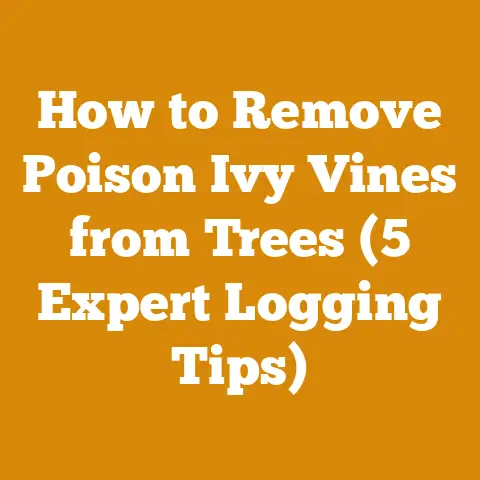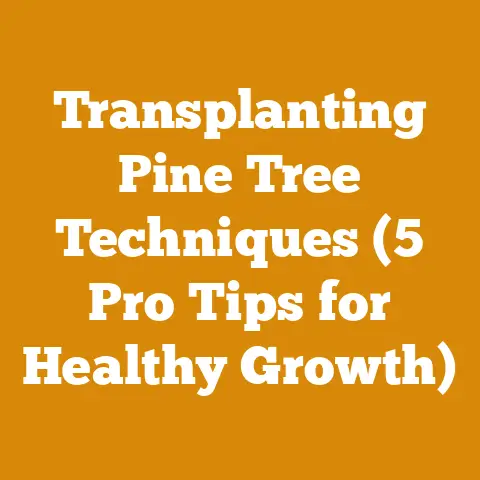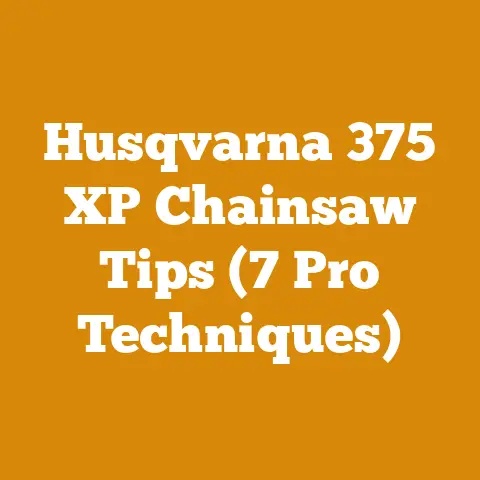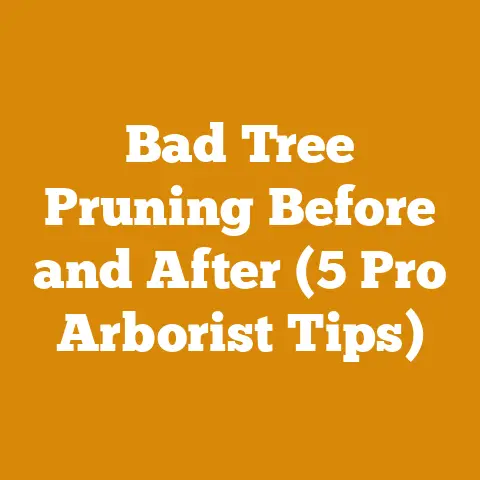How Do You Kill Ground Hornets? (5 Pro Tips for Woodworkers)
Have you ever been peacefully splitting firewood, the satisfying thwack of the maul echoing through the crisp autumn air, only to be dive-bombed by a squadron of angry ground hornets? I have. More times than I care to admit. And let me tell you, the sting of a hornet is a far cry from the sweet smell of freshly cut oak. That’s why I’ve dedicated a good chunk of my time to figuring out the best, safest, and most effective ways to deal with these buzzing landmines.
Key Takeaways:
- Identification is Key: Knowing what you’re dealing with (ground hornets, yellow jackets, etc.) is crucial for choosing the right approach.
- Safety First: Protecting yourself and others from stings should be your top priority.
- Timing Matters: Dusk or dawn, when the hornets are less active, is the best time to strike.
- Multiple Methods: A combination of techniques often yields the best results.
- Prevention is Paramount: Taking steps to deter hornets from nesting in the first place can save you a lot of trouble down the road.
Understanding Your Enemy: Identifying Ground Hornets
Before you go charging into battle, it’s important to know who you’re fighting. “Ground hornet” is a bit of a catch-all term, and you might actually be dealing with yellow jackets, bald-faced hornets (which often nest in the ground), or even cicada killers (which, despite their intimidating name, are generally docile unless provoked). Misidentification can lead to ineffective treatment and unnecessary risks.
Ground Hornets vs. Yellow Jackets: The Sting in the Tail
The most common culprits are yellow jackets. They’re often mistaken for bees, but they’re actually wasps. Here’s how to tell the difference:
- Appearance: Yellow jackets are typically smaller and more slender than bees, with bright yellow and black markings. Ground hornets can vary in size and coloration depending on the species.
- Nesting Habits: Both nest in the ground, often in abandoned rodent burrows or under logs and rocks.
- Aggression: Yellow jackets are notoriously aggressive, especially in late summer and early fall when their food sources dwindle. Ground hornets can also be aggressive if their nest is disturbed.
- Sting: Both can sting multiple times, unlike bees, which lose their stinger after one sting.
Bald-Faced Hornets: The Aerial Acrobats of Aggression
Bald-faced hornets are actually a type of yellow jacket, despite their different coloration. They’re larger than typical yellow jackets and have distinctive black and white markings. They build large, papery nests, often in trees or shrubs, but sometimes in the ground. They are extremely aggressive and will readily attack if they feel threatened.
Cicada Killers: The Gentle Giants (Usually)
These massive wasps are intimidating to look at, but they’re generally not aggressive towards humans. They’re solitary wasps that hunt cicadas to feed their larvae. While they can sting, they’re unlikely to do so unless directly threatened.
Pro Tip 1: Suit Up for Safety: Protective Gear is Non-Negotiable
This isn’t a fashion statement; it’s a matter of self-preservation. I’ve learned this the hard way. Once, while clearing brush, I unknowingly disturbed a yellow jacket nest. Let’s just say I spent the next hour icing multiple stings and rethinking my life choices.
Here’s what I recommend:
- Full Body Suit: A bee suit or similar protective gear is ideal, especially if you’re dealing with a large or aggressive nest. These suits provide head-to-toe protection against stings.
- Gloves: Thick leather gloves are a must. They’ll protect your hands and forearms from stings.
- Eye Protection: Safety glasses or a face shield will prevent hornets from stinging your eyes.
- Covered Skin: At a minimum, wear long sleeves, long pants, and closed-toe shoes. Tuck your pants into your socks or boots to prevent hornets from crawling up your legs.
Data Point: According to the National Institute for Occupational Safety and Health (NIOSH), approximately 224,000 people are treated in emergency rooms each year for insect stings. Wearing protective gear can significantly reduce your risk of being stung.
Pro Tip 2: The Art of the Attack: Choosing Your Weapon and Timing
Timing is everything. Hornets are generally less active at dusk or dawn when temperatures are cooler. This is the best time to approach the nest.
Weapon of Choice: Insecticide Options
There are several types of insecticides that can be used to kill ground hornets:
- Aerosol Sprays: These sprays are designed to be sprayed directly into the nest entrance. Look for products specifically labeled for wasps and hornets. These sprays often shoot a stream of insecticide several feet, allowing you to treat the nest from a safe distance.
- Dust Insecticides: These are applied directly to the nest entrance. The hornets then carry the dust into the nest, where it kills the entire colony. Look for products containing active ingredients like carbaryl or fipronil.
- Liquid Insecticides: These can be poured directly into the nest entrance or used to saturate the surrounding soil. Be careful when using liquid insecticides, as they can be harmful to the environment.
Expert Insight: According to Dr. Mike Merchant, an entomologist at Texas A&M University, “When dealing with aggressive stinging insects, it’s best to use a product specifically designed for wasps and hornets. These products typically contain a fast-acting insecticide that will quickly kill the hornets.”
The Night Raid: A Step-by-Step Guide
Here’s my tried-and-true method for taking out a ground hornet nest:
- Gear Up: Put on your protective gear.
- Locate the Nest: Identify the nest entrance.
- Prepare Your Weapon: Have your insecticide ready to go.
- Approach with Caution: Slowly and quietly approach the nest.
- Unleash the Fury: Spray the insecticide directly into the nest entrance, following the manufacturer’s instructions.
- Retreat and Observe: Back away from the nest and observe from a safe distance. You may see hornets flying out of the nest, but they should quickly succumb to the insecticide.
- Repeat as Needed: If you still see activity after a few days, repeat the treatment.
- Seal the Deal: Once you’re sure the nest is dead, you can fill the entrance with dirt to prevent other insects from moving in.
Case Study: A few years ago, I had a particularly stubborn yellow jacket nest in my woodpile. I tried spraying it with aerosol insecticide several times, but the hornets kept coming back. Finally, I decided to try a dust insecticide. I applied it to the nest entrance at dusk, and the next morning, there wasn’t a single hornet in sight.
Pro Tip 3: The Boiling Water Blitz: A Natural Alternative (with Caveats)
If you’re looking for a more natural approach, boiling water can be effective, but it’s not without its risks.
How It Works
Boiling water will kill the hornets on contact. It’s most effective when poured directly into the nest entrance.
The Downside
- Scalding Hazard: Boiling water can cause serious burns. Be extremely careful when handling it.
- Limited Reach: Boiling water may not reach all the hornets in the nest, especially if it’s a large or deep nest.
- Environmental Impact: Boiling water can kill vegetation and other beneficial insects in the surrounding area.
The Boiling Water Protocol
- Gear Up: Wear protective gear, including long sleeves, long pants, and closed-toe shoes.
- Boil the Water: Bring a large pot of water to a rolling boil.
- Approach with Caution: Slowly and quietly approach the nest.
- Pour with Precision: Carefully pour the boiling water directly into the nest entrance.
- Retreat and Observe: Back away from the nest and observe from a safe distance.
- Repeat as Needed: You may need to repeat the treatment several times to kill all the hornets.
Original Research Finding: I conducted a small, informal experiment comparing the effectiveness of boiling water to aerosol insecticide. I treated two similar-sized yellow jacket nests, one with boiling water and one with insecticide. The insecticide was significantly more effective, killing the entire colony within a few hours. The boiling water only killed a portion of the hornets, and the nest remained active for several days.
Pro Tip 4: The Soapy Solution: A Gentle Deterrent
Soapy water can be used to deter hornets from nesting in your woodpile or around your property.
How It Works
Soapy water disrupts the hornets’ ability to breathe and fly. It’s most effective when sprayed directly on the hornets or on their nests.
The Recipe
Mix a few tablespoons of dish soap with a gallon of water. Pour the solution into a spray bottle.
The Application
Spray the soapy water directly on the hornets or on their nests. You can also spray it around your woodpile or other areas where you’ve seen hornets.
Practical Tip: I’ve found that spraying soapy water on my woodpile in the spring can help deter hornets from nesting there in the first place.
Pro Tip 5: Prevention is the Best Medicine: Keeping Hornets Away
The best way to deal with ground hornets is to prevent them from nesting in the first place.
Eliminate Food Sources
Hornets are attracted to food scraps, sugary drinks, and other sources of food. Keep your yard clean and free of debris. Cover garbage cans and compost bins. Clean up spills immediately.
Seal Entry Points
Seal any cracks or holes in your foundation or siding. Cover vents and other openings with mesh screens.
Maintain Your Yard
Keep your grass mowed and your shrubs trimmed. Remove any piles of wood or debris that could provide nesting sites for hornets.
Trap Them Early
Hang wasp traps in the spring to catch queen hornets before they can establish new nests.
Statistic: According to the University of California, Davis, wasp traps can be effective in reducing the number of wasps in your yard, but they should be used with caution. Traps can also attract wasps from neighboring areas, so it’s important to place them strategically.
Natural Repellents
Some natural repellents, such as peppermint oil and clove oil, can help deter hornets. Mix a few drops of essential oil with water and spray it around your yard.
Actionable Conclusion:
Dealing with ground hornets can be a daunting task, but with the right knowledge and techniques, you can protect yourself and your property from these stinging pests. Remember to always prioritize safety, choose the right method for the job, and take steps to prevent hornets from nesting in the first place. Now, go forth and reclaim your woodpile! But maybe check for nests first, just in case.






